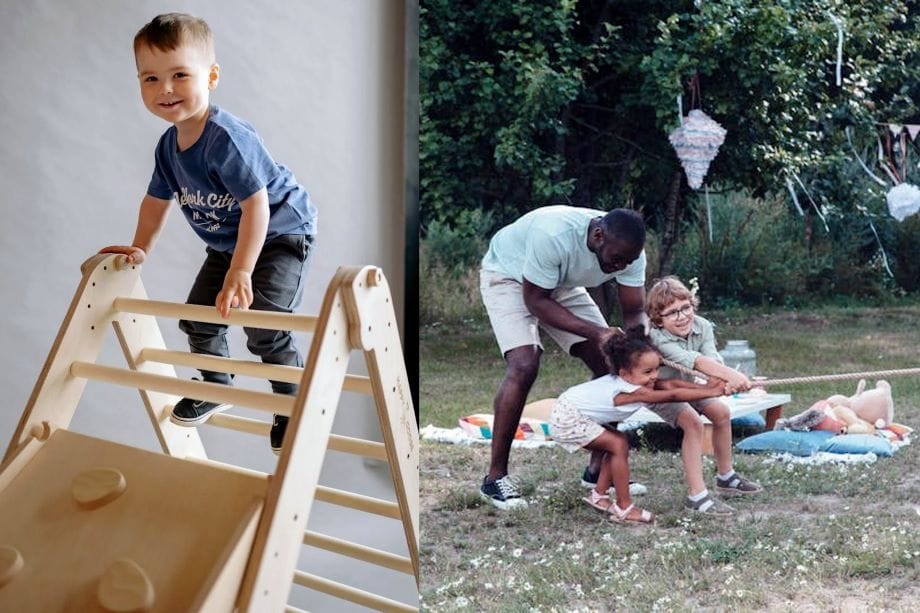Indoor or Outdoor Play? Why Both Matter for Your Child’s Growth

Is your child getting enough physical activity? For many parents, especially in busy cities or small spaces, it’s a common worry. Between unpredictable weather, packed schedules, and limited outdoor access, it’s not always easy to give children the freedom to run, jump, and explore.
But here’s the good news: whether inside or outside, play is one of the most effective ways to support your child’s physical development.
Let’s explore how both indoor and outdoor play help young children grow strong, confident, and healthy—and how you can make it work in your home, no matter your lifestyle.
Why Physical Play Matters
In the early years, children are building strength, coordination, balance, and control. Every time they crawl through a tunnel, throw a ball, dance to music, they climb a ladder, they’re developing important gross and fine motor skills.
According to researchers Burdette and Whitaker (2005), outdoor play in particular improves motor development and emotional well-being. Then again, indoor play, especially in a safe, stimulating environment, can be just as powerful.
Indoor Play: Fun in Small Spaces
Indoor play doesn’t need to be complicated. Living rooms can become dance floors, obstacle courses, or tunnels made from cushions and blankets. Even yoga, building blocks, or movement games like “Simon Says” count as active play.
Benefits:
- Safe from weather and pollution
- Easier to supervise
- Great for calm, creative, or sensory-sensitive kids
Challenges:
- Limited space for large movements
- Requires creativity to keep fresh
Outdoor Play: Let Kids Roam and Explore
When children play outside—at the park, in a yard, or even on a sidewalk—they stretch their bodies in ways that aren’t always possible indoors. They run, climb, dig, ride, and explore.
Benefits:
- Encourages large muscle growth and exploration
- Exposure to sunlight and fresh air
- Opportunities for risk-taking and building confidence
- Supports social play
Challenges:
- Weather and safety concerns
- May be limited by location or access to outdoor space
No Yard? No Problem. Make It Work for You
You don’t need a big yard or long playtime sessions to make a difference. Even 15–20 minutes of active play, indoors or out, daily, can benefit your child’s development.
Try a dance break before dinner, scooter time after school, or morning yoga together. Work with what your schedule and space allow.
“But I Don’t Want My House Turned Upside Down…”
Some parents worry about clutter and chaos, which can result from active indoor play. If you value a tidy home, you’re not alone—and you don’t have to sacrifice order to support your child’s growth.
Try these simple strategies:
- Create a play zone: Use a rug, mat, or corner for active play.
- Use collapsible equipment, such as yoga mats, tunnels, or bean bags that can be tucked away neatly.
- Set time limits: Let children know when play starts and ends.
- Clean up together: Make cleanup part of the fun using music or a race.
A little mess is often a sign of creativity and learning. You can have movement and a manageable home.
Your Role as a Parent: More Than Supervision
Whether you’re playing tag at the park or dancing in the kitchen, your involvement is what makes play truly meaningful. Children are more engaged when caregivers participate, encourage, or share in the joy of movement.
You don’t have to be perfect, just present and connected Your energy and enthusiasm matter more than fancy toys or perfect timing.
Bottom Line: Keep It Balanced
It’s not about indoor versus outdoor play—it’s about making room for both in your child’s day. Movement helps your child build not just a strong body, but also emotional resilience, social skills, and confidence.
So whether you're navigating tight spaces or braving the outdoors, remember:
Play is how your child learns to live in their body, and love it, especially with your involvement!
Reference: Burdette, H. L., & Whitaker, R. C. (2005). Resurrecting free play in young children: Looking beyond fitness and fatness to attention, affiliation, and affect. Archives of Pediatrics & Adolescent Medicine, 159(1), 46–50.